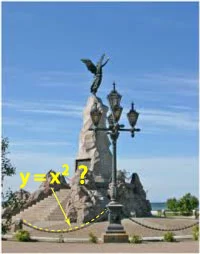Equation of Catenary
The catenary is a plane curve, whose shape corresponds to a hanging homogeneous flexible chain supported at its ends and sagging under the force of gravity.
The catenary is similar to parabola (Figure 1).

So it was believed for a long time. In the early \(17\)th century Galileo doubted that a hanging chain is actually a parabola. However, a rigorous proof was obtained only half a century later after Isaak Newton and Gottfried Leibniz developed a framework of differential and integral calculus.
The solution of the problem about the catenary was published in \(1691\) by Christiaan Huygens, Gottfried Leibniz, and Johann Bernoulli.
Below we derive the equation of catenary and some its variations.
Suppose that a heavy uniform chain is suspended at points \(A, B,\) which may be at different heights (Figure \(2\)).
Consider equilibrium of a small element of the chain of length \(\Delta s.\) The forces acting on the section of the chain are the distributed force of gravity
where \(\rho\) is the density of the chain material, \(g\) is the acceleration of gravity, \(A\) is the cross sectional area of the thread, and the tension forces \(T\left( x \right)\) and \(T\left( {x + \Delta x} \right),\) respectively, at points \(x\) and \({x + \Delta x}.\)
The equilibrium conditions of the element of the length \(\Delta s\) for projections on the axes \(Ox\) and \(Oy\) are written as
It follows from the first equation that the horizontal component of the tension force \(T\left( x \right)\) is always a constant:
Using differentials in the second equation we can rewrite it as
As \(T\left( x \right) = \frac{{{T_0}}}{{\cos\alpha \left( x \right)}},\) we have
Take into account that \(\tan \alpha \left( x \right) = \frac{{dy}}{{dx}} = y',\) so the equilibrium equation can be written in the differential form as
The chain element of the length \(\Delta s\) is expressed by the formula
As a result we obtain the differential equation of the catenary:
The order of this equation can be reduced. By denoting \(y^{\prime} = z,\) we can represent it as the first order equation:
The last equation can be solved by separating variables.
Here we denoted \(\frac{{\rho gA}}{{{T_0}}}\) as \(\frac{1}{a}.\)
The tangent to the catenary at the lowest point is parallel to the \(x\)-axis. Hence,
We can determine the constant \({C_1}\) from here:
Thus, we get the following equation:
Multiplying both sides of the equation by the conjugate expression \(z - \sqrt {1 + {z^2}} \) gives
Adding to the previous equation, we find the expression for \(z = y':\)
Integrating once more gives the final nice expression for the shape of the catenary:
Thus, the catenary is described by the hyperbolic cosine function. Its shape is uniquely determined by the parameter \(a = \frac{{{T_0}}}{{\rho gA}}\) as shown in Figure \(3.\)
Catenaries are often found in nature and technology. For example, the square sail under the pressure of the wind takes the form of a catenary (this problem has been considered by Jacob Bernoulli).
The archs in the form of an inverted catenary (such as Saarinen's Gateway Arch in St.Louis shown in Figure \(4\)) are often used in architecture and construction.

They have a high stability because the internal compression forces are ideally compensated and do not cause sagging.
The catenary has another interesting feature. When revolved about the x-axis, the catenary gives the surface called catenoid. This surface has minimum surface area, i.e. any part of the catenoid will be less than any other surface bounded by the same contour. In particular, the soap film between two circles trying to minimize the free energy takes the form of a catenoid.